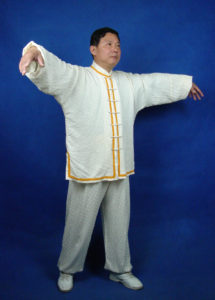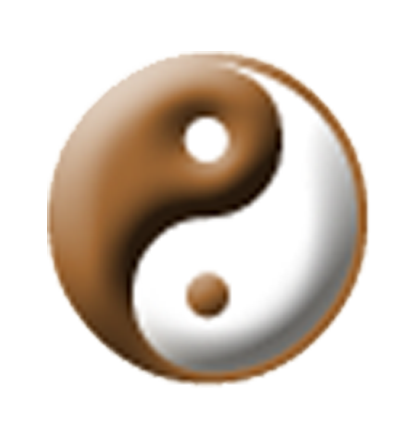04. Diagonal Flying
Practice Method and Details
The following is from our book on Wudang Qigong, originally published in 1999. Photos of Professor Liu here are from 2006.

Set 4 Diagonal Flying Exercise
The person who practices White Crane Skill has long life,
diagonally soaring, the body moves like a gentle breeze.
View the myriad things of the world as dust,
with the HEART FIELD naturally the breathing will join.
1) Preparation
The movement method is exactly the same as for Extreme Emptiness Exercise, Preparation Postures. (see Illustrations 1-1, 1-2, 1-3, 1-4)
2) Left Diagonal Flying
The previous movement pauses slightly, after regulating the breath by breathing out and in two times, the body turns to the left 45 degrees, the weight is left six right four, the heel of the right foot raises changing to a left six four stance. At the same time, the body faces the upper left and unfolds, both arms follow the body’s turning movement, from the sides of the body rising to the left in an arc upward gradually and slowly flying together, the shoulders relax, the elbows sink down,; the wrist joints press up with force, slightly higher than the shoulders. The fingertips point downward at an angle to the ground, the palms face inward, the Lao Gong acupuncture points are connected from a distance with the San Li acupuncture points of the feet. At the same time, the dan tian sinks inward, breathe in. The tongue presses against the upper palate; the teeth are slightly closed. The eyes follow the moving body, the intention is at the left wrist Nei Guan and Wai Guan acupuncture points. (Illustrations 4-1 and 4-2)
The previous movement does not stop, the body’s center of gravity lowers, both legs bend at the knees squatting and changing to a left six four stance. At the same time, both wrist joints bend down, both arms lower stopping at both sides of the body. The fingertips face up at an angle, the palms face down. At the same time as this, the dan tian sticks outward, breathe out. The tongue is close to the lower palate, the teeth are lightly closed. The eyes look into the distance, the intention is on the tip of the middle finger Zhong Chong acupuncture point, the breath travels through the hands’Jue Yin Xinbao channel. (Illustration 4-3)
3) Right Diagonal Flying
The previous movement pauses slightly, the body turns right 90 degrees, the weight is right six left four, the heel of the left foot rises and lifts changing to a right six four stance. At the same time, the body turns toward the right and rises describing an arc as it rises, the shoulders relax, the elbows sink down, the wrist joints use strength to rise up, slightly higher than the shoulders. The fingertips point at the ground at an angle, the palms face inward, the Lao Gong acupuncture points are connected from a distance with the San Li acupuncture points of the feet attracting and pressing each other. At the same time, the dan tian sinks inward, breathe in. The tongue presses against the upper palate; the teeth are slightly closed. The eyes follow the motion of the body, the intention is on the right wrist Nei Guan and Wai Guan acupuncture points. (Illustration 4-4)
The previous movement does not stop, the body’s center of gravity lowers, both legs bend at the knees squatting down and changing to a right six four stance. At the same time, both wrist joints sink down, both arms lower down at an angle stopping at both sides of the body. The palms face down, the fingertips angle upward. At the same time, the dan tian sticks outward, breathe out. The tongue is close to the lower palate, the teeth are lightly closed. The eyes look toward the front, the intention is at the tip of the middle finger Zhong Chong acupuncture point, the breath travels through the hands’ Jue Yin Xin Bao channel (Illustration 4-5)
4) Turn the Body Return to the Beginning
The previous movement pauses slightly, after regulating the breath by breathing out and in two times, both legs extend and straighten, naturally standing erect. At the same time, both arms revolve toward the outside, both hands follow this turning inward and rising upward, the heels of the palms stop just below both breasts. The fingertips face front, the palms face up. At the same time as this, the dan tian sinks inward, breathe in. The tongue presses against the upper palate, the teeth are slightly closed; the eyes look toward the front. (Illustration 4-6)
The movement methods are entirely the same as for Extreme Emptiness Exercise, Blend the Elements with one breath (see Illustration 1-8).
Main Points and Functions
In practicing Crane Diagonal Skill, the entire movement must be connected and coordinated, while the body turns the waist must be used as an axle, the body should be especially straight, it cannot lean forward or backward, slant to the left or lean to the right. The backs of the hands must naturally curve, the wrists rising and falling, must follow the movement in rising, using strength to press up, follow the movement falling sitting the wrists and raising the fingers. The entire movement of turning the body when lifting breathe in, when the body’s center of gravity lowers breathe out, must be well distributed and natural, it cannot be forced.
When practicing, also pay attention to three firmnesses: When the nape of the neck naturally rises and is firm then the breath passes through and is concentrated at the Bai Hui acupuncture point. When the waist is firm and the body open, then the breath passes through and is concentrated in the four limbs. When the knees are firm and detained (while) lowering, then the breath is tranquil and the energy guarded.
Crane Diagonal Exercise is a principle method for practicing energy, breath, and spirit. The length of a person’s lifetime is determined by the extent of energy, breath, and spirit. Persist in regular practice, maintain it as a permanent practice exercise, and the energy will be enough, the breath will be complete, and the spirit will flourish.
Practice Method:
Each time, practice 6 times or 12 times to make one set. Practicing again and again in succession is fine. The size of the movements, large or small, high or low is not restricted, but depends on the age or youth, the extent of physical strength, and the strength or weakness of the physique of the one who is practicing.
09/16/2022 Terri Morgan
